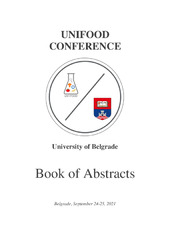Приказ основних података о документу
Encapsulation of Rosa canina extract in liposomes produced by thin film method
| dc.creator | Jovanović, Aleksandra A. | |
| dc.creator | Balanč, Bojana | |
| dc.creator | Trajković, Milica | |
| dc.creator | Đorđević, Verica | |
| dc.creator | Šavikin, Katarina | |
| dc.creator | Živković, Jelena | |
| dc.creator | Bugarski, Branko | |
| dc.date.accessioned | 2023-05-24T12:05:12Z | |
| dc.date.available | 2023-05-24T12:05:12Z | |
| dc.date.issued | 2021 | |
| dc.identifier.isbn | 978-86-7522-066-4 | |
| dc.identifier.uri | http://TechnoRep.tmf.bg.ac.rs/handle/123456789/6411 | |
| dc.description.abstract | Rosa canina pseudo-fruit is rich in bioactive substances, such are carotenoids, ascorbic acid, polyphenols, fatty acids and minerals. Because of its diuretic, anti-inflammatory, anti-allergic and antioxidant properties it is frequently employed in traditional medicine. However, in order to protect mentioned bioactive compounds and to improve its bioavailability and controlled release, numerous encapsulation methods have been developed. Thus, R. canina ethanol extract obtained using percolation at ambient temperature (25°C), was encapsulated into Lipoid G liposomes produced in thin film procedure. Total polyphenol and flavonoid contents, as well as antioxidant potential of the extract and extract loaded liposomes were determined. Encapsulation efficiency, particle size, polydispersity index and zeta potential of the liposomes with extract were monitoring during 30 days. Total polyphenol and flavonoid contents of the extract were 103.8±1.9 mg of gallic acid equivalents/g of the extract and 64.2±2.4 mg of catechin equivalents/g of the extract, respectively; antioxidant potential of the extract was 15.3±2.1 mg of Trolox equivalents/g of the extract (ABTS assay) and 1.07±0.01 mg/mL of the extract (DPPH assay). Total polyphenol and flavonoid contents of the extract loaded liposomes were 0.316±0.023 mg of gallic acid equivalents/mg of lipids and 0.219±0.009 mg of catechin equivalents/mg of lipids, respectively; antioxidant potential of the sample was 0.134±0.004 mg of Trolox equivalents/mg of lipids (ABTS assay) and 270.6±10.5 mg/mL of liposomal suspension (DPPH assay). Encapsulation efficiency was the same during monitoring period and it was amounted 46.6±3.4%. Particle size and polydispersity index of the liposomes with extract were increased from 618.2±10.9 to 1698.0±104.2 nm and from 0.441±0.007 to 0.589±0.011, respectively, during 30 days. On the other hand, zeta potential of the extract loaded liposomes was decreased from -10.24±0.95 to -7.21±0.77 mV. R. canina extract loaded liposomes developed in this study have potential to be used in food, pharmacological and cosmetic industries due to beneficial health effects of R. canina active compounds encapsulated into liposomes. | sr |
| dc.language.iso | en | sr |
| dc.publisher | University of Belgrade | sr |
| dc.relation | info:eu-repo/grantAgreement/MESTD/inst-2020/200287/RS// | sr |
| dc.relation | info:eu-repo/grantAgreement/MESTD/inst-2020/200135/RS// | sr |
| dc.relation | info:eu-repo/grantAgreement/MESTD/inst-2020/200003/RS// | sr |
| dc.rights | openAccess | sr |
| dc.rights.uri | https://creativecommons.org/licenses/by/4.0/ | |
| dc.source | 2nd International UNIfood Conference | sr |
| dc.subject | encapsulation efficiency | sr |
| dc.subject | liposomes | sr |
| dc.subject | Rosa canina | sr |
| dc.subject | thin film method | sr |
| dc.title | Encapsulation of Rosa canina extract in liposomes produced by thin film method | sr |
| dc.type | conferenceObject | sr |
| dc.rights.license | BY | sr |
| dc.citation.epage | 176 | |
| dc.identifier.fulltext | http://TechnoRep.tmf.bg.ac.rs/bitstream/id/17153/bitstream_17153.pdf | |
| dc.identifier.rcub | https://hdl.handle.net/21.15107/rcub_technorep_6411 | |
| dc.type.version | publishedVersion | sr |

